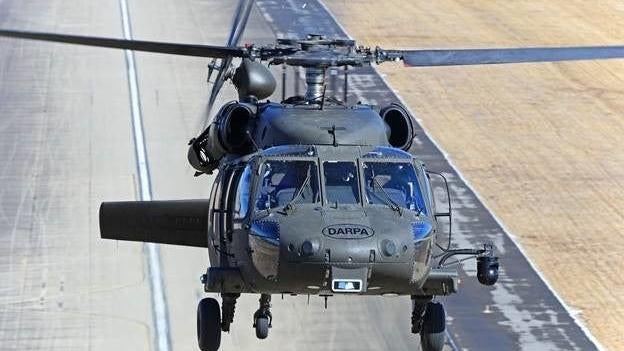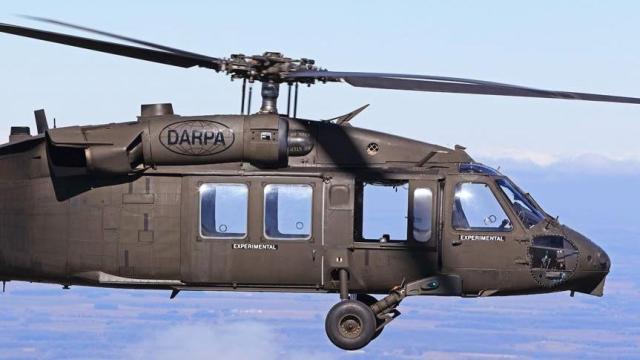The United States military just inched one step closer to bringing autonomous helicopters to the battlefield. Like most strange feats of advanced military technology, this one comes from The Pentagon’s Defence Advanced Research Projects Agency, better known simply as “DARPA.”
On Tuesday, DARPA said a UH-60A Black Hawk helicopter outfitted with its experimental Aircrew Labour In-Cockpit Automation System (ALIAS) system safely completed a test flight without anyone in the chopper. The 30-minute test flight occurred over the weekend above a U.S. Army installation at Fort Campbell, Kentucky.
DARPA describes its Aircrew Labour In-Cockpit Automation System (ALIAS) as a “tailorable, drop-in, removable kit,” meant to add sophisticated automation to pre-built aircraft at a fraction of the cost of upgrading individual models with new, advanced avionics and software. The agency imagines this system will one day reduce pilot workloads and ultimately improve aircraft safety.
“With reduced workloads pilots can focus on mission management instead of the mechanics,” DARPA Tactical Technology Office Program Manager Stuart Young said in a statement. “This unique combination of autonomy software and hardware will make flying both smarter and safer.”
ALIAS was used last year in a supervised test where it was accompanied by a safety pilot. In that case, a video of the event made public by Lockheed Martin shows an S-70 OPV Black Hawk taking off from the ground autonomously, avoiding simulated obstacles, and landing.
Stuart went on to say a fully autonomous helicopter system could provide the U.S. military more “operational flexibility” to conduct missions in scenarios deemed too difficult for humans. “This includes the ability to operate aircraft at all times of the day or night, with and without pilots, and in a variety of difficult conditions, such as contested, congested, and degraded visual environments,” Stuart said.
DARPA’s interest in autonomous vehicles broadly dates back decades. In 2004, 2005, and 2007, the agency held its series of “Grand Challenges,” which awarded millions in prize money to competitors who could design vehicles able to autonomously navigate over long distances. AV technology has since undergone transformational change compared to 2024 when not a single vehicle was able to complete DARPA’s 229 km desert course.

DARPA isn’t just interested in helicopters either. A report released last month in The New Yorker detailed advancements the agency has made in adding autonomous functions to fighter jets as part of its Air Combat Evolution program. In some simulated events, automated fighter jets systems have already outperformed human pilots in dogfights. If all goes according to plan, DARPA says it aims to showcase four AI-powered jets engaged in a live dogfight over Lake Ontario by 2024.
Overall, that New Yorker report claims the Pentagon has more than six hundred projects vying to incorporate AI into warfighting.
These advancements in autonomous military tech occur despite growing backlash from many in the international community around autonomous weapons systems, which some have dubbed, “killer robots.” According to Human Rights Watch, at least 30 countries, including Argentina, Mexico, Nicaragua, and Pakistan, have all called for an international ban on so-called killer robots. And no, the U.S. isn’t on that list.
In fact, just last month U.S. diplomats rejected United Nations calls for a binding agreement regulating or banning the use of “killer robot” autonomous weapons systems arguing instead for a toothless, “non-binding code.” It’s worth noting here that, at least currently, DARPA’s autonomous helicopter project does not appear to include weapons systems. The experimental AI fighter pilots meanwhile are intended to keep a human “in the loop” to monitor the AI and make any final decision if an offensive situation were to occur.

Those restrictions could potentially ease or disappear entirely as militaries ramp up their AI capabilities. To that end, the U.S. has shown a strong interest in making AI tools more prevalent, not less. In its first major report released in late 2020, the National Security Commission on AI (led by former Google CEO Eric Schmidt) called, amongst other things, for a ramping up of cooperation between the military and private industry to act as a counterweight against alleged aggression from China and Russia.
“We will not be able to defend against AI-enabled threats without ubiquitous AI capabilities and new warfighting,” the commission wrote.
Those views were flushed out in more detail last year in a book called The Age of AI, co-authored by Schmidt and notorious Cold War veteran Henry Kissinger. In it, Kissinger and Schmidt argue the U.S. and China are poised to go toe-to-toe in an ever-escalating AI arms race. The winner of that technological skirmish, the authors argue, could dictate the balance of power for international relations in the 21st century.
While it’s easy to dismiss these musings as the verbose alarmist hecklings of powerful men perpetually trapped in the past century, both of those figures still play a prominent role in U.S. politics, and their ideas are actively helping shape real-world policy goals.
Then again, there’s also the possibility the autonomous aircraft advancement sponsored at DARPA could one day trickle down to more consumer-facing technologies. In the past, the agency has had a hand in inventing everything from GPS and speech translation to the earlier predecessors to the internet. It also had some other colossal flops. And for those not exactly totally on board with the prospect of autonomous military vehicles, DARPA has some, um, “reassuring” news.
“It might look disconcerting to see a Lockheed Martin, Sikorsky Black Hawk helicopter flying itself,” the agency wrote in a tweet, “But, don’t worry, we’ve got this!” Great.
More: Here’s What Henry Kissinger Thinks About the Future of Artificial Intelligence
